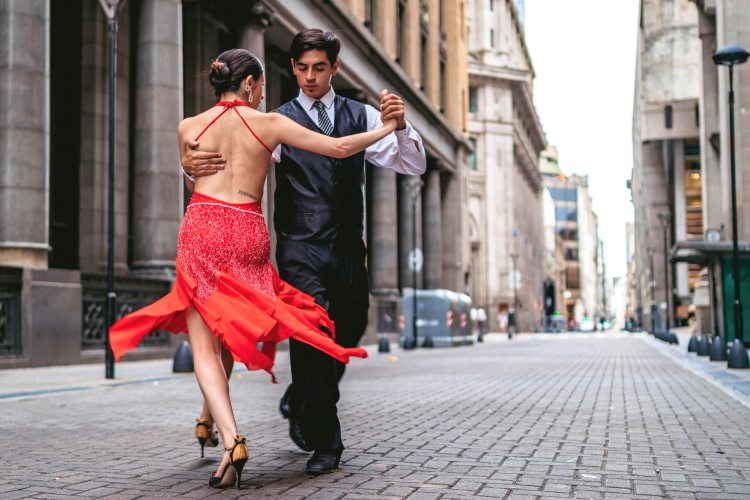How Dance San Francisco can Save You Time, Stress, and Money.
Wiki Article
See This Report on Dance San Francisco
Table of ContentsDance San Francisco for BeginnersThe Ultimate Guide To Dance San FranciscoA Biased View of Dance San FranciscoSome Known Facts About Dance San Francisco.
Allow's consider Salsa dancing and music as a large Tree that appears like this: Salsa is danced worldwide while lots of technological aspects of the dancing coincide across designs (6 actions over 8 beats danced on a quick-quick-slow or slow-quick-quick rhythm), there are a number of "trademark" attributes of the major designs of Salsa that identify one from the other.Pairs joining a Gambling establishment Rueda dance all relocate unison as called by a Leader. Distinguishing attributes of Cuban design salsa are circular turn patterns (with "break back" steps on matters 1 and 5) in addition to body language motivated by standard Afro-Cuban folkloric dancings. Distinguishing features of Cali style salsa is quick and complex maneuvering, danced with a strong hand hold connection between companions.
The beginnings of the design are a topic of dispute, but it is stated that New york city design Salsa dancing came from in the 1960's due to the influx of Latin American emigrants after the Cuban Change (salsa dancing sf). Eddie Torres is the most well understood New york city style dancer, being nearly globally credited with popularizing the design to dance centres beyond New york city
The basic rhythm of "On-2" is slow-quick-quick. The "youngest" of the styles of Salsa, L.A (https://www.goodreads.com/user/show/172172305-evan-margolin). Style (some people have actually called it "West Coast" design) became preferred in the 1990's and has its origins in ballroom (Mambo, Swing and Cha, Cha, Cha). Transform patterns lead and comply with techniques are greatly influenced by these styles, with the Cross Body Lead being the foundation of the design
The Best Guide To Dance San Francisco
Design are implementation of turn patterns and figures in the "port", with the break steps on matters "1" and "5". While Salsa music has solid origins in Cuban, Colombian and Puerto-Rican folkoric practices, it can not be marked down that all Afro-Latin and Latin American societies have contributed to modern Salsa songs as we know it today.

There she became good friends with the Nuyorican musicians, and her collaborations with them and her time with the Fania All-Stars brought about over 50 cds (of collective and solo job). Thanks to the internet and convenience of access to information, the appeal of Salsa music, dancing and culture has actually spread out like wildfire over the last 30 years and also then modern Salsa artists remain to pay homage to the Founding Papas and Mom of Salsa.

The Single Strategy To Use For Dance San Francisco
identifying qualities of Salsa songs are: 4/4 measure signature, Son Clave and Tumbao rhythms, Montuno Piano Unless you have a background in music, the above 3 attributes possibly mean nothing to you. A simpler method to define you can look here Salsa songs is just how it does NOT sound like other kinds of Latin American popular music.
It's time for lessons. With so numerous studios available and different styles to pick from, where does a total novice begin? The majority of all new professional dancers pick to find out L.A. "On-1" design slotted Salsa designs are one of the most widespread in The United States and Canada (with some exemptions of some metropolitan centres that still mainly accept Cuban and Puerto Rican styles) and L.A.
.A. Style will rapidly show you the principles of Salsa timing, weight transfer and transform pattern implementation. Lots of professional dancers, when they've had a year or 2 of dancing L.A. Design Salsa under their belts, "button" to New york city style in order to diversify their dance vocabulary; yet several professional dancers make a decision to stay with just one style of Salsa and appreciate their time on the dancing floor in that particular design. salsa dancing sf.
Design and New York City Style all being danced in the same club, with most of the professional dancers having the ability to change from one design to the other from one track to the following. salsa dancing sf. No issue which style you pick it is very important to adhere to that style until you're really comfy with the fundamentals of timing, body rhythm and structure step execution before taking into consideration "changing" styles (if you desire to)
When you embark on lessons be all set to dedicate energy and time to finding out exactly how to dance as a whole it takes a total beginner (i. e., a person with little or no dance experience) about 6 months of proactively taking lessons and going out and exercising at least twice a week to reach a point where pattern implementation starts to really feel "natural".
Report this wiki page